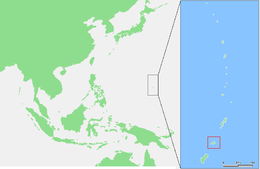|
Rota, Northern Mariana Islands
Rota (Chamorro: Luta), also known as the "Friendly Island", is the southernmost island of the United States Commonwealth of the Northern Mariana Islands (CNMI) and the third southernmost of the Marianas Archipelago (the first being Cocos Island). In early Spanish records it is called "Zarpana"; the name Rota may have come from the Spaniards possibly naming the island after the municipality of Rota, Spain.[citation needed] It lies approximately 40 nautical miles (74 km) north-northeast of the United States territory of Guam. Sinapalo village is the largest and most populated, followed by Songsong village (Songsong). Rota also functions as one of the four municipalities of the CNMI. HistoryIn 1521, the first European to see Rota was the lookout on Ferdinand Magellan's ship Victoria, Lope Navarro. However, Magellan's armada of three ships did not stop until they reached Guam, so the first European to arrive in Rota (in 1524), was the Spanish navigator Juan Sebastián Elcano, who annexed it together with the rest of the Mariana Islands on behalf of the Spanish Empire. As with the other islands of the northern Marianas, Rota was sold to the German Empire under the German–Spanish Treaty of 1899. In World War I, the islands were occupied by the Japanese Empire. In 1919, the League of Nations formally recognized Japanese control under the South Seas Mandate. However, development of Rota lagged behind that of neighboring Tinian and Saipan, with only 1000 Japanese residents arriving by the end of December 1935, most of them employed in raising sugar cane and in sugar refining. The refinery was not economical, and it was closed three years later. The Japanese garrison during World War II consisted of 1,031 Imperial Japanese Army men of the 10th Independent Mixed Brigade, under the command of Major Shigeo Imagawa, and about 600 Imperial Japanese Navy men.[2] During the final stages of the war, Rota was occasionally bombed by aircraft of the U.S. Navy in an attempt to silence its radio transmitter that was providing warning to the Japanese home islands upon the take-off of B-29 Superfortress bomber attacks from Tinian, Saipan, and Guam, but the island was never invaded by American troops. B-29 bombers on Guam would use Rota to dump their bombs if they had mechanical issues and needed to turn back during a raid on Japan. On September 2, 1945, one hour after the surrender of Japan, a detachment of U.S. Marines arrived on Rota to accept the surrender of the Japanese garrison, which numbered 947 Imperial Japanese Army and 1853 Imperial Japanese Navy. After the end of World War II, Rota became part of the Trust Territory of the Pacific Islands. Since 1978, the island has been a part of the Commonwealth of the Northern Mariana Islands. The current mayor is Aubry M. Hocog. In the 21st century, tourism is popular on the island, with a variety of natural, historic, and marine sites.[3] One noted tourist and natural wonder is the "swimming hole", which is small naturally formed pool of sea water by the coast.[4][3]  GeographyRota is 12.3 miles (19.8 km) long and 4.2 mi (6.8 km) wide.[5] Its coastline is about 38 mi (61 km) long. The highest point on Rota is Mt. Sabana which is 495.56 meters (1,625.9 ft). Rota is 47 nmi (87 km) north of Guam, 63 nmi (117 km) south of Tinian and 73 nmi (135 km) south of Saipan. Ecology Rota has diverse flora and fauna including the endemic and endangered Rota white-eye, Mariana crow, and Mariana fruit bat.[6] Much of the island, especially where there are remnants of native forest, have been recognised as forming an Important Bird Area (IBA) by BirdLife International.[7] Four wildlife conservations areas have been designated on Rota: Mariana Crow Conservation Area, Sabana Protected Area, I'Chenchon Park Wildlife Conservation Area, and Liyo Conservation Area.[8] There are five plant species or subspecies that are endemic only to the island of Rota, including the critically endangered Osmoxylon mariannense and the endangered Nesogenes rotensis.
Climate
TransportationRota has an airport, Rota International Airport. From here an airline operates commuter plane flights to nearby islands. Rota has two harbors, and the western one was completed in 1985.[11] See also List of numbered highways in the Northern Mariana Islands EducationPost-secondaryNorthern Marianas College established the Rota Instructional Site to provide post-secondary, continuing, and adult education and training opportunities for the purpose of improving the quality of life for the people of Rota. Since its inception in August 1986, the Rota Instructional Site has assisted many people who chose to pursue college education locally over the high cost of post-secondary education elsewhere. Many students have obtained a Certificate of Completion, an associate degree, or the Bachelor of Science degree in Elementary Education, have found better paying jobs, and have continued pursuing higher degrees. The results are positive, and the community has depended on NMC for quality education and training. Presently, Rota offers a variety of programs:
Primary and secondaryCommonwealth of the Northern Mariana Islands Public School System operates public schools. Rota has two public schools:
Rota's elementary school and junior high school (middle school) were formerly located in the same area and shared class buildings at Songsong village. After the new elementary school was built in Sinapalo, the Songsong village school ground was reopened as Rota Junior High. In 2010, the junior high school was renamed for the former Commissioner of Education, Dr. Rita Hocog Inos.[citation needed] Rota has two private schools:
Public libraryAntonio C. Atalig Memorial Rota Public Library of the State Library of the Commonwealth of the Northern Mariana Islands is in Songsong, Rota.[13] The current library was built circa 2002 but it did not open until its "soft" opening on February 26, 2012.[14] It was named after Mayor of Rota Antonio C. Atalig.[13] It adopted its current name in 1981.[15] Topography Soil types Gallery
ReferencesSee also
References
Wikimedia Commons has media related to Rota Island. |
||||||||||||||||||||||||||||||||||||||||||||||||||||||||||||||||||||||||||||||||||||||||||||||||||||||||||||||||||||||||||||||||||||||||||||||||||||||||||||||||||||||||||||||
Portal di Ensiklopedia Dunia





